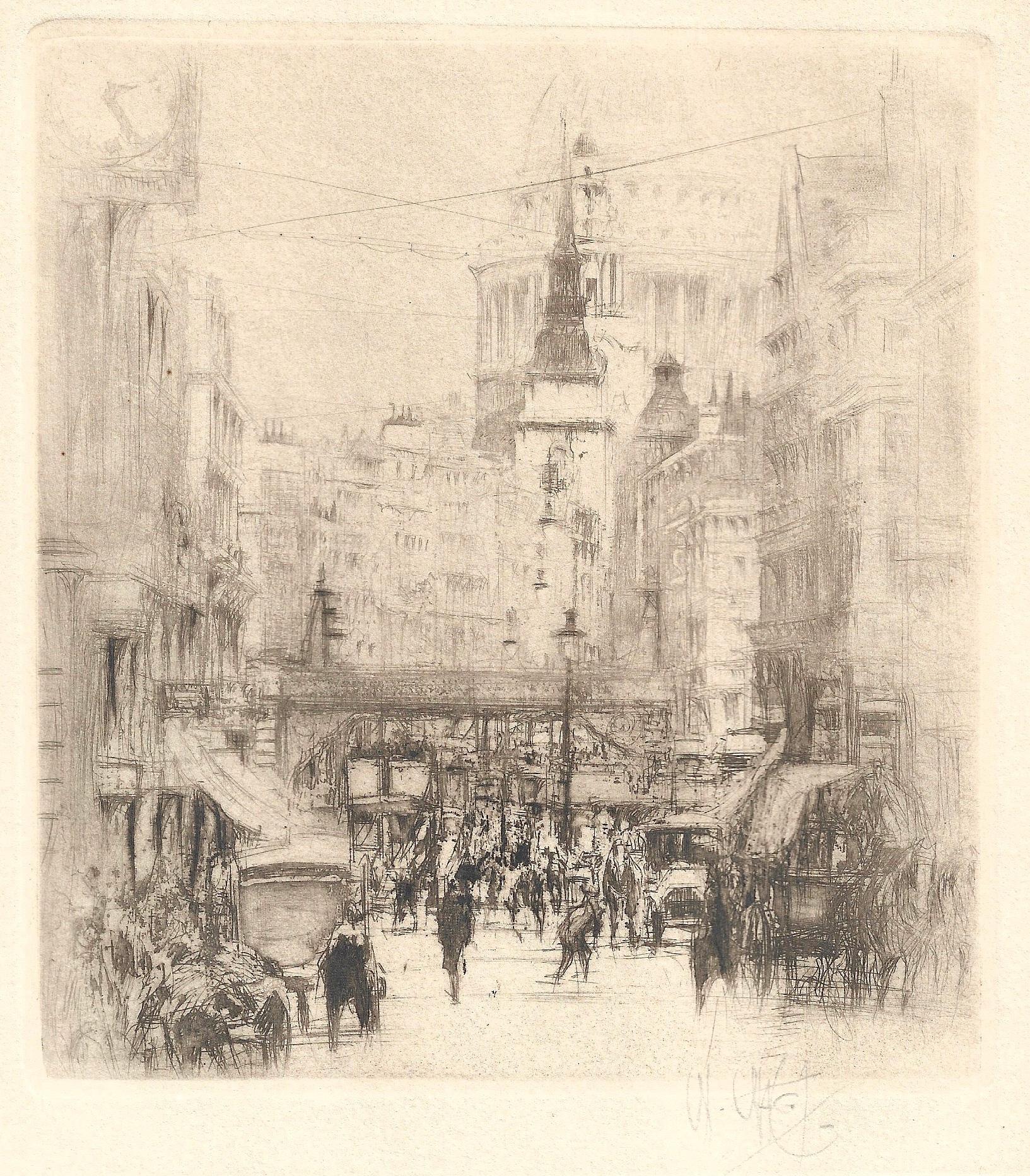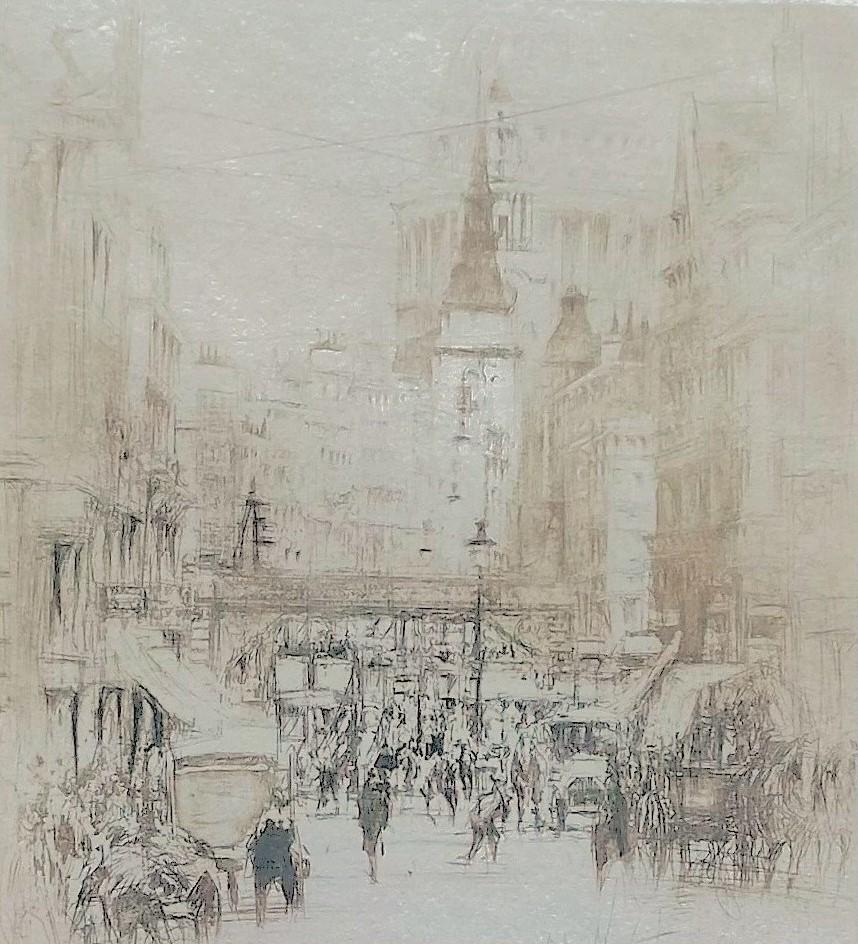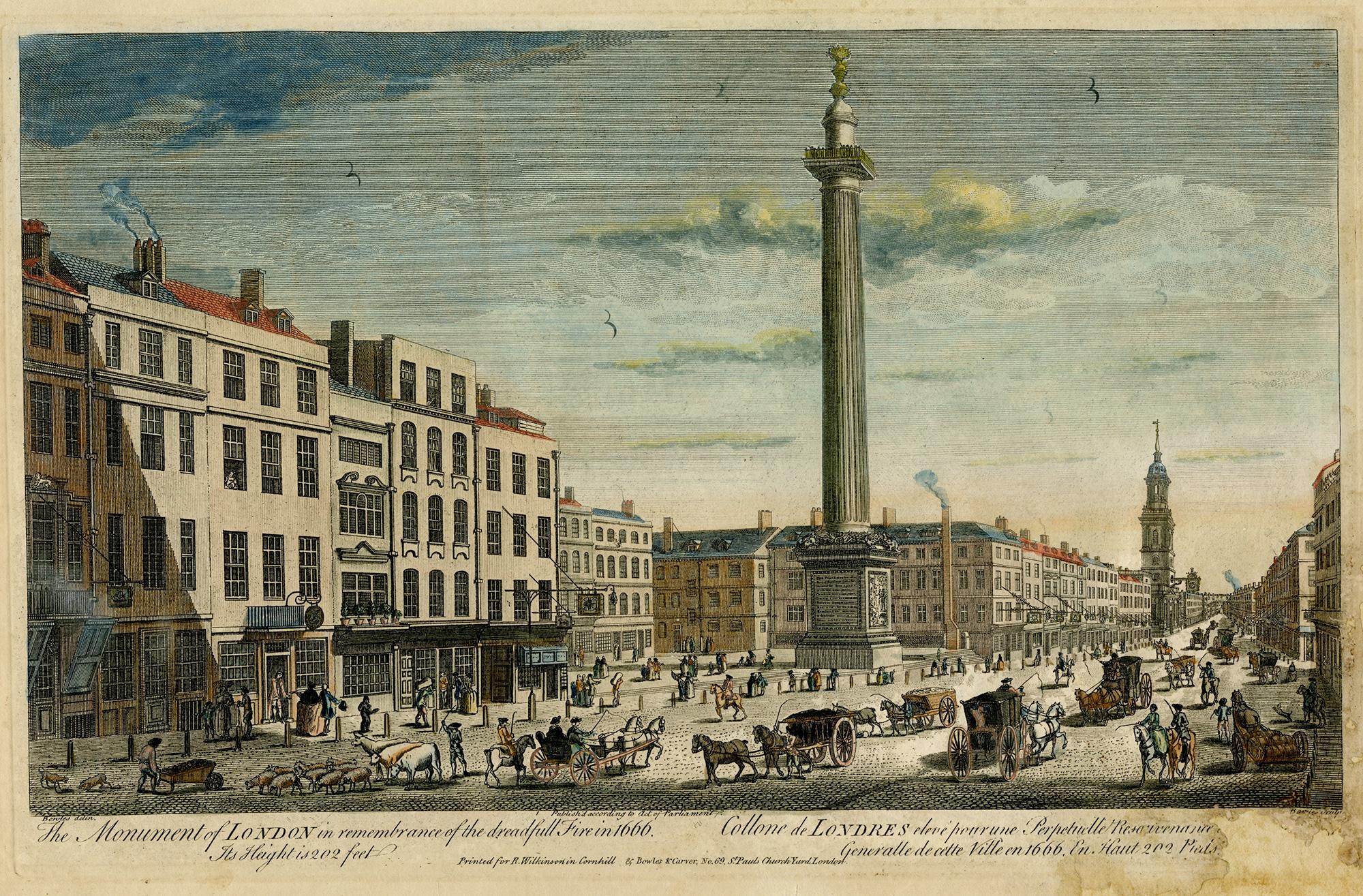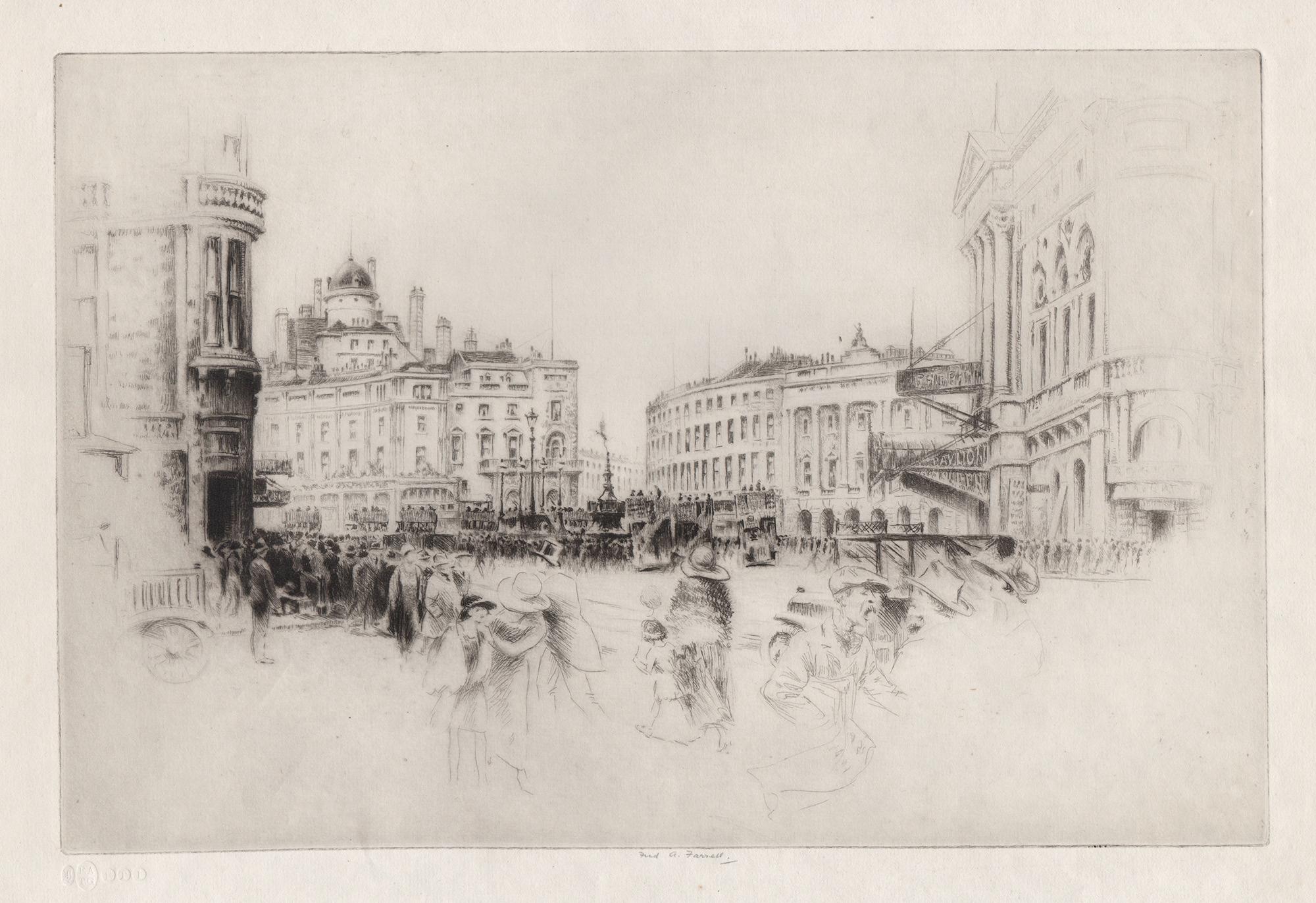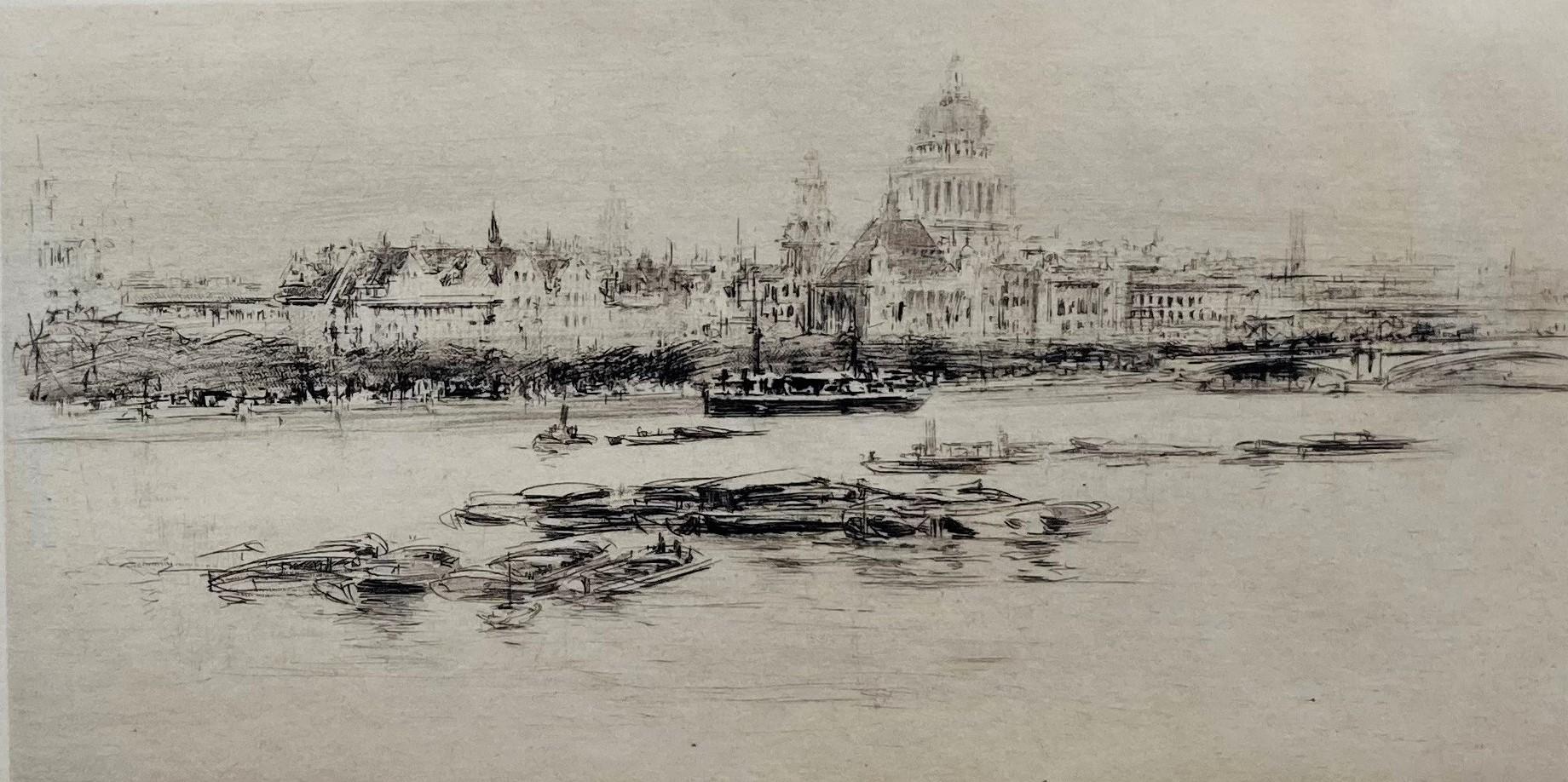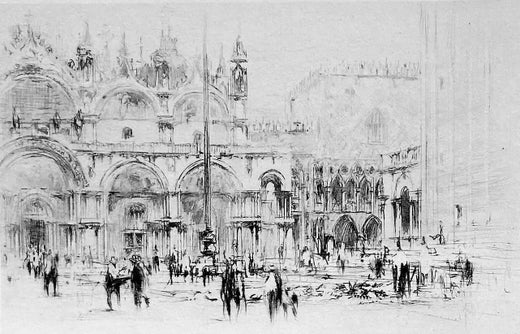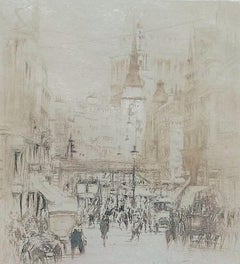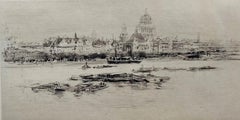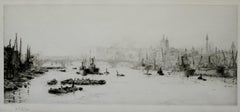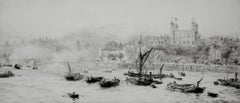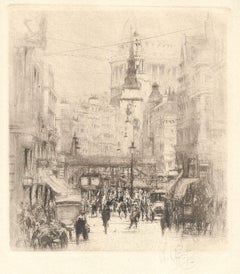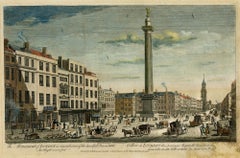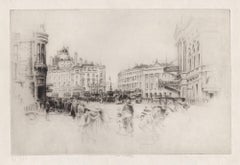Items Similar to Charing Cross - The Statue of Charles I.
Want more images or videos?
Request additional images or videos from the seller
1 of 4
William Walcot R. E. Hon. R. I. B. A.Charing Cross - The Statue of Charles I.1919
1919
$780
$97520% Off
£604.91
£756.1420% Off
€688.17
€860.2220% Off
CA$1,116.07
CA$1,395.0920% Off
A$1,219.40
A$1,524.2520% Off
CHF 641.33
CHF 801.6720% Off
MX$14,660.27
MX$18,325.3420% Off
NOK 8,074.92
NOK 10,093.6520% Off
SEK 7,581.28
SEK 9,476.6020% Off
DKK 5,138.71
DKK 6,423.3920% Off
About the Item
Charing Cross -- The Statue of Charles I. 1919. Etching with aquatint and drypoint. 3 5/8 x 4 7/8 (sheet 9 1/8 x 11 3/8). A fine proof with tonal wiping, printed on cream-wove paper. Signed in pencil.
Charing Cross is located at the junction of the Strand, Whitehall, and Cockspur Street in Central London, England. The name originates from the Eleanor cross installed by King Edward I as a memorial to his wife, Eleanor of Castile at the former hamlet of Charing. Since 1675, the cross site has been occupied by a statue of King Charles I mounted on a horse. The pedestal is thought to be designed by Wren and carved by Grinling Gibbons.
Chelsea Old Church, also known as All Saints, is an Anglican church, on Old Church Street, Chelsea, London SW3, England, near Albert Bridge. It is the church for a parish in the Diocese of London, part of the Church of England. Inside the Grade I listed building, there is seating for 400 people. There is a memorial plaque to the author Henry James (1843–1916) who lived nearby on Cheyne Walk. To the west of the church is a small public garden containing a sculpture by Sir Jacob Epstein.
When he was seventeen,William Walcot began to study architecture under Louis Benois at the Imperial Academy of Art in Saint Petersburg. He went to Paris where he continued his studies at the Ecole des Beaux-Arts and the Atelier Redon. He practiced as an architect briefly in Moscow, designing the Hotel Metropole in 1898.
In 1907, Walcot settled in London where he was employed as a draughtsman by the South-African-born architect, Eustace Frere. In 1933, Walcot designed one London building, 61 St. James Street, but his main architectural activity was that of a freelance draughtsman. He produced drawings and etchings for architects to show their clients and to exhibit at the Royal Academy summer exhibitions.
Throughout the 1920s and 1930s, Walcot was the most celebrated architectural draughtsman in England, enhancing the scale and drama of the buildings he depicted with his mastery of techniques including watercolor and gouache.
- Creator:William Walcot R. E. Hon. R. I. B. A. (1874 - 1943, British)
- Creation Year:1919
- Dimensions:Height: 3.63 in (9.23 cm)Width: 4.88 in (12.4 cm)Depth: 0.5 in (1.27 cm)
- Medium:
- Movement & Style:
- Period:
- Condition:
- Gallery Location:Storrs, CT
- Reference Number:1stDibs: LU335211565742
William Walcot R. E. Hon. R. I. B. A.
When he was seventeen, William Walcot began to study architecture under Louis Benois at the Imperial Academy of Art in Saint Petersburg. He went to Paris where he continued his studies at the Ecole des Beaux-Arts and the Atelier Redon. He practiced as an architect briefly in Moscow, designing the Hotel Metropole in 1898. In 1907, Walcot settled in London where he was employed as a draughtsman by the South-African-born architect, Eustace Frere. In 1933, Walcot designed one London building, 61 St. James Street, but his main architectural activity was that of a freelance draughtsman. He produced drawings and etchings for architects to show their clients and to exhibit at the Royal Academy summer exhibitions. Throughout the 1920s and 1930s, Walcot was the most celebrated architectural draughtsman in England, enhancing the scale and drama of the buildings he depicted with his mastery of techniques including watercolor and gouache.
About the Seller
5.0
Recognized Seller
These prestigious sellers are industry leaders and represent the highest echelon for item quality and design.
Established in 1977
1stDibs seller since 2016
727 sales on 1stDibs
Associations
International Fine Print Dealers Association
- ShippingRetrieving quote...Shipping from: Storrs, CT
- Return Policy
Authenticity Guarantee
In the unlikely event there’s an issue with an item’s authenticity, contact us within 1 year for a full refund. DetailsMoney-Back Guarantee
If your item is not as described, is damaged in transit, or does not arrive, contact us within 7 days for a full refund. Details24-Hour Cancellation
You have a 24-hour grace period in which to reconsider your purchase, with no questions asked.Vetted Professional Sellers
Our world-class sellers must adhere to strict standards for service and quality, maintaining the integrity of our listings.Price-Match Guarantee
If you find that a seller listed the same item for a lower price elsewhere, we’ll match it.Trusted Global Delivery
Our best-in-class carrier network provides specialized shipping options worldwide, including custom delivery.More From This Seller
View AllLudgate Hill
By William Walcot R. E. Hon. R. I. B. A.
Located in Storrs, CT
Ludgate Hill. 1921. Etching, aquatint, and drypoint. Dickins 69. 5 5/8 x 5 1/8 (sheet 13 5/8 x 9 3/4). A fine proof with plate tone, printed on 'J Wha[tman] cream wove paper. Edition of 275 for the UK and 125 for the US. Signed in pencil.
Ludgate Hill is a street that runs west from St. Paul's Churchyard to Ludgate Circus (built in 1864), and from there becomes Fleet Street. The Ludgate Hill railway station, between Water Lane and New Bridge Street, is a station of the London, Chatham, and Dover Railway. It was closed before World War II and the railway bridge and viaduct between Holborn Viaduct and Blackfriars stations was demolished in 1990 to enable the construction of the City Thameslink railway station in a tunnel. This also involved the regrading of the slope of Ludgate Hill at the junction. About halfway up Ludgate Hill is St Martin, Ludgate church. This was physically joined to the Ludgate.
When he was seventeen, William Walcot began to study architecture under Louis Benois at the Imperial Academy of Art in Saint Petersburg. He went to Paris where he continued his studies at the Ecole des Beaux-Arts and the Atelier Redon. He practiced as an architect briefly in Moscow, designing the Hotel...
Category
Early 20th Century Modern Landscape Prints
Materials
Drypoint, Etching, Aquatint
$400 Sale Price
20% Off
The Thames from Waterloo.
By William Walcot R. E. Hon. R. I. B. A.
Located in Storrs, CT
The Thames from Waterloo Bridge. 1913. Etching. Dickins 12. 3 3/4 x 7 1/16 (sheet 7 x 10 15/16). Edition 100. A fine proof with tonal wiping, printed on cream-wove paper. Signed in pencil.
Architectural draughtsman, etcher. Born in Lustdorf, near Odessa, Russia, to a British father and Russian mother. Traveled extensively with his family before studying architecture in St Petersburg, with further studies at Ecole des Beaux-Arts and Atelier Redan, Paris. Practiced architecture in Moscow and was co-designer of the Metropole Hotel, in 1898. Moved to London in 1907 and was employed as an architectural perspectivist. After a sponsored visit to Rome and Venice he had a solo exhibit at the Fine Art Society, 1912, 'Watercolours of London and Venice'; followed by a further four shows. He also exhibited at the Royal Academy, Royal Society of British Artists, Royal Society of Painter-Etchers..., and Connell & Sons. His etchings were published in London by H C Dickens,1913-24, and a folio of his work 'Architectural watercolors and etchings of William Walcot' was published, in 1919. Elected RE, 1920; FRIBA, 1922; Associate British School at Rome. A foremost architectural draughtsman, he worked from studios in London, Oxford and Rome.
The complete set of The Arteries of Great Britain includes: The Thames, The Tyne, The Forth, The Clyde, The Mersey. Signed in pencil .Housed in a 16 x 20 inch mat suitable for framing.
Opened in 1890, the Forth Bridge...
Category
Early 20th Century Modern Landscape Prints
Materials
Etching
$620 Sale Price
20% Off
London Bridge.
By William Lionel Wyllie
Located in Storrs, CT
London Bridge, London. 1924. Etching and drypoint. 6 3/8 x 14 3/4 (sheet 9 7/8 x 17 1/4). Mat line; otherwise fine condition. A rich impression with dryp...
Category
1920s Modern Landscape Prints
Materials
Drypoint, Etching
$975 Sale Price
22% Off
The Thames and the Tower of London
By William Lionel Wyllie
Located in Storrs, CT
The Thames and the Tower of London. 1924. Etching and drypoint. 6 3/8 x 14 3/4 (sheet 10 1/4 x 17 1/4). Mat line; otherwise fine condition. A rich impr...
Category
1920s Modern Landscape Prints
Materials
Drypoint, Etching
$975 Sale Price
22% Off
The Pool of London.
By William Lionel Wyllie
Located in Storrs, CT
The Pool of London. c. 1915. Etching and drypoint. 7 7/8 x 15 7/8 (sheet 11 x 14 7/8 x 21 1/4). A rich impression with drypoint burr printed on the full sheet of simili-Japan paper. ...
Category
1910s Modern Landscape Prints
Materials
Drypoint, Etching
$1,500 Sale Price
23% Off
Chelsea Old Church, London
By William Walcot R. E. Hon. R. I. B. A.
Located in Storrs, CT
Chelsea Old Church. 1924. Etching, drypoint, and aquatint. Dickins 94. 5 3/8 x 8 (sheet 8 1/2 x 9 3/4). Edition 100 for The Print Collector's Club. A fine proof with tonal wiping, printed on cream wove paper. Signed and dedicated "W.R. Button from W. Walcot London 1930" in pencil.
Chelsea Old Church, also known as All Saints, is an Anglican church, on Old Church Street, Chelsea, London SW3, England, near Albert Bridge. It is the church for a parish in the Diocese of London, part of the Church of England. Inside the Grade I listed building, there is seating for 400 people. There is a memorial plaque to the author Henry James (1843–1916) who lived nearby on Cheyne Walk. To the west of the church is a small public garden containing a sculpture by Sir Jacob Epstein.
When he was seventeen,William Walcot began to study architecture under Louis Benois at the Imperial Academy of Art in Saint Petersburg. He went to Paris where he continued his studies at the Ecole des Beaux-Arts and the Atelier Redon. He practiced as an architect briefly in Moscow, designing the Hotel Metropole...
Category
Early 20th Century Modern Landscape Prints
Materials
Drypoint, Etching, Aquatint
$400 Sale Price
20% Off
You May Also Like
Ludgate Hill
By William Walcot R. E. Hon. R. I. B. A.
Located in Middletown, NY
Etching with drypoint and aquatint on light cream wove paper, 5 1/2 x 5 inches (140 x 122 mm), full margins. Signed in pencil in the lower margin. One of a total of 400 signed impres...
Category
Early 20th Century Modern Landscape Prints
Materials
Etching, Aquatint, Drypoint
The Monument of London in Remembrance of the Dreadful Fire of 1666
Located in Middletown, NY
Bowles, Thomas III (after John Donowell)
John Bowles & Richard Wilkinson, 1751.
Steel engraving with extensive hand coloring in watercolor on cream wove paper, 10 1/4 x 16 inches (...
Category
Mid-18th Century English School Landscape Prints
Materials
Watercolor, Handmade Paper, Engraving
Piccadilly Circus, London, etching by Frederick Farrell, circa 1920
Located in Melbourne, Victoria
Signed in pencil below the image by the artist. Blind stamps of etching societies lower left just under the image.
Frederick Farrell was a Scottish etcher specializing in architectu...
Category
1920s Other Art Style Landscape Prints
Materials
Drypoint, Etching
Statue of Louis XIV - Original etching, Signed
Located in Paris, IDF
Jacques Rigaud (c. 1671/91-1754)
Statue of Louis XIV
Original etching
Signed in the plate
On Arches vellum 38 x 56.5 cm (14.9 x 22.2 inch)
INFORMATION : Published by the Chalcograp...
Category
18th Century Other Art Style Prints and Multiples
Materials
Etching
Navona Square - Original Etching by Giuseppe Malandrino - 1970s
By Giuseppe Malandrino
Located in Roma, IT
Navona Square - Rome is an original artwork realized by Giuseppe Malandrino.
Original print in etching technique.
Hand-signed by the artist in pencil on the lower right corner. Num...
Category
1970s Modern Figurative Prints
Materials
Etching
Paris - Fontaine de la Place du Chatelet, French lithograph, 1861
By Philippe Benoist
Located in Melbourne, Victoria
'Fontaine de la Place du Chatelet', tinted lithograph by Felix Benoist (1818-1896).
From a series of lithographs depicting the famous buildings of Paris -...
Category
Late 19th Century Naturalistic Landscape Prints
Materials
Lithograph
